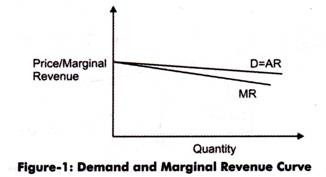

The concept of marginal revenue is useful when it is combined with other marginal concepts, especially marginal cost, which refers to the change in total cost when output changes.

In market structures other than perfect competition, the demand curve is downward sloping, in which case Δ P / Δ Q < 0, and so marginal revenue is less than price and the marginal revenue curve lies below the average revenue curve -the curve that denotes the price for any level of output. Under perfect competition, the price does not change whatever the level of output, so Δ P / Δ Q = 0 and hence marginal revenue is equal to price, which in turn is equal to average revenue.

Hence, marginal revenue can be expressed as Because total revenue is price times quantity, then TR = P.Q and Δ TR = P. The relationship between marginal revenue and demand is obtained by considering the change in total revenue ( Δ TR ). In perfect competition the demand curve is horizontal at a particular price, whereas for the typical demand curve, it is downward sloping, indicating that the quantity rises when the price falls. The demand curve is also the average revenue curve, because it denotes the price people are willing to pay for each particular quantity. When used in terms of market structure, marginal revenue is related to the demand curve. Where MR denotes marginal revenue, TR denotes total revenue, and Q the level of output. Marginal revenue refers to the change in total revenue arising from a change in output, where the change in output can denote a rise or fall and is usually thought of as a one-unit change. Since then it has been taught in all courses in microeconomics as part of the theory of the firm. It became a central concept in discussion of market structure with the publication of Joan Robinson ’s The Economics of Imperfect Competition and Edward Chamberlin ’s The Theory of Monopolistic Competition, both published in 1933. Marginal revenue is a concept introduced into economics by neoclassical economists, especially Alfred Marshall in his Principles of Economics (1890).


 0 kommentar(er)
0 kommentar(er)
